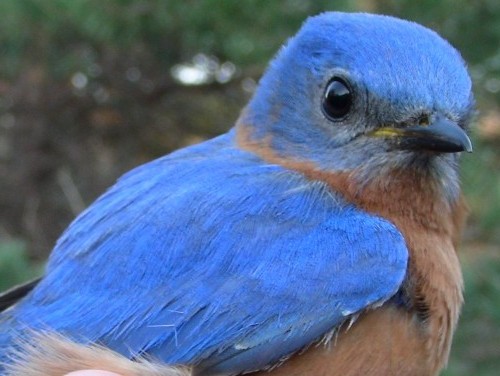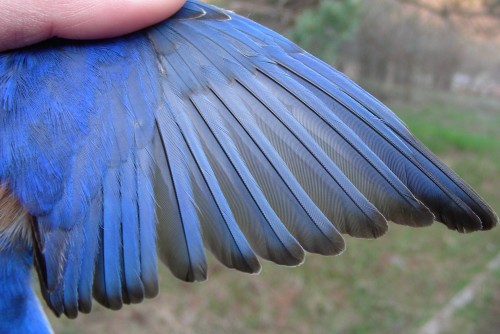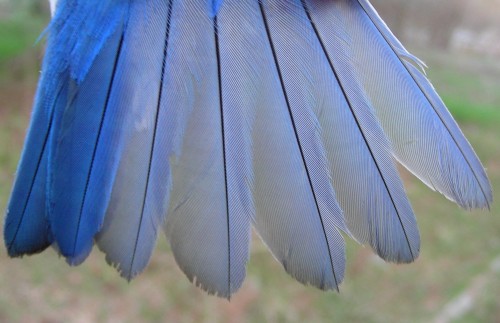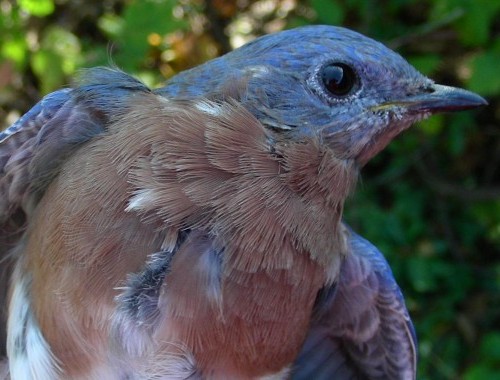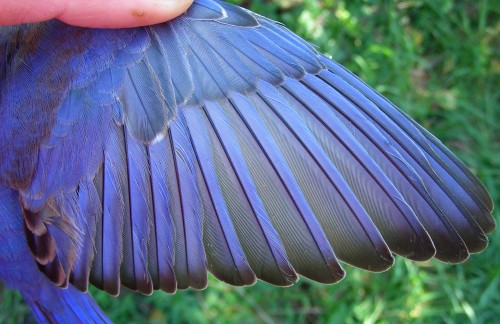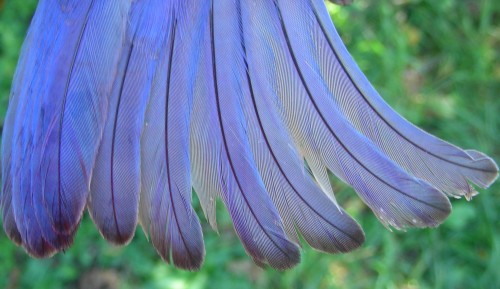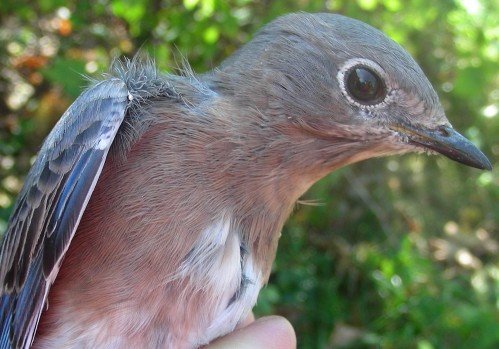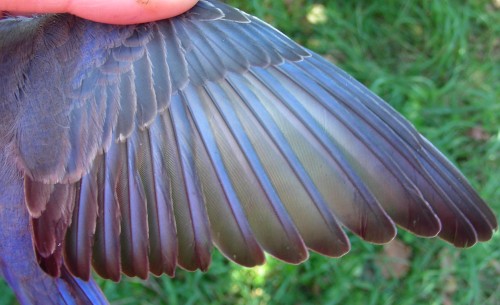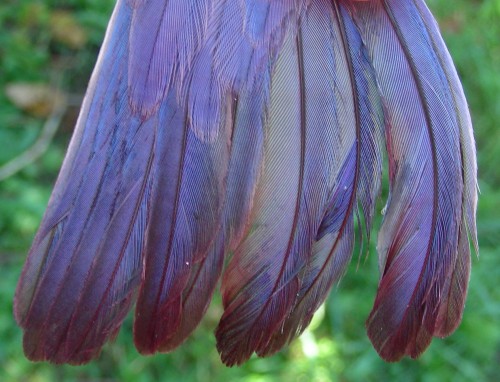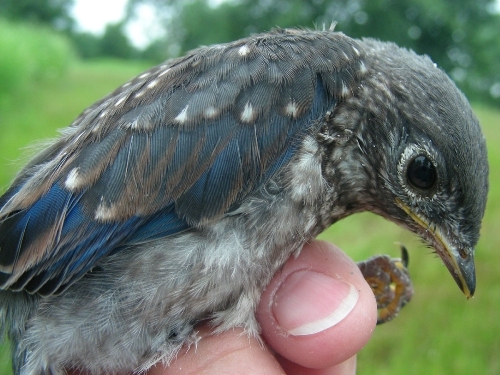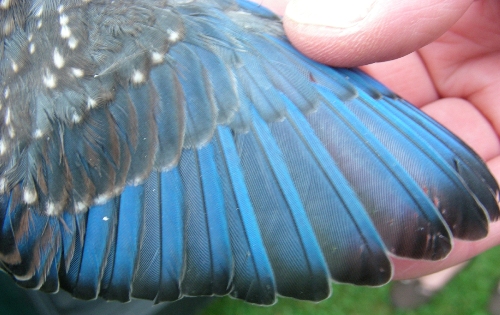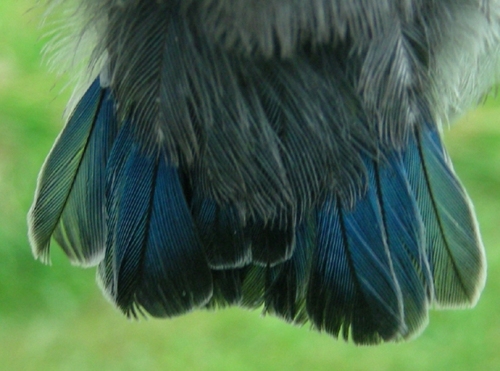|
McGILL BIRD OBSERVATORY |
|||||||||||||||||||||||||||||||
Ageing and sexing details: ASY male Eastern Bluebirds can be recognized by their bright blue upperparts and solid dark orange breast.
ASY Eastern Bluebirds have wings that are uniform in colour and quality; males are bright blue, while females show a similar pattern buy are somewhat more grayish.
ASY Eastern Bluebirds have relatively broad and rounded rectrices, but note that some SY individuals will have replaced their entire tail during their preformative molt and will therefore be inseparable from ASY individuals with respect to the tail.
ASY female Eastern Bluebirds have largely grayish upperparts with bluish tinges to the wing and tail, and a fairly orange upper breast.
The wing of ASY Eastern Bluebirds is uniform in colour and quality; females are grayish-blue, noticeably paler than males.
ASY female Eastern Bluebirds have broad and rounded rectrices similar to those of males, but usually somewhat duller blue in colour. but note that some SY individuals will have replaced their entire tail during their preformative molt and will therefore be inseparable from ASY individuals with respect to the tail SY male Eastern Bluebirds are dull blue above, with a fairly extensive orange breast. Although they are often distinctly paler than AHY males, the wing may need to be viewed to confirm age.
SY Eastern Bluebirds usually have a molt limit among the greater coverts, though in some individuals all greater coverts are replaced during the preformative molt, and the limit is instead between the greater coverts and the primary coverts. In either case, males usually show a moderately distinct contrast between the replaced blue inner feathers and the retained brownish-blue outer feathers.
Since HY Eastern Bluebirds may replace none, some, or all of their rectrices during their preformative molt, the tail can either be very useful or useless for ageing SY individuals. If all rectrices have been replaced, the tail will look identical to that of ASY bluebirds, and cannot be used to determine age. However, a mix of juvenile (narrow and relatively pointed) and formative (broad and fairly rounded) rectrices is unique to SY bluebirds, and a tail comprising entirely juvenile rectrices can also be used to identify a bluebird as SY.
SY female Eastern Bluebirds are largely gray above with only traces of dull blue, and with relatively limited dull orange on the breast. Although they are somewhat paler than AHY females, the open wing may need to be examined to be confident of age.
SY Eastern Bluebirds usually have a molt limit among the greater coverts, though in some individuals all greater coverts are replaced during the preformative molt, and the limit is instead between the greater coverts and the primary coverts. In either case, females usually show a distinct contrast between the replaced blue inner feathers and the retained grayish-brown outer feathers that usually only have a trace of blue.
Since HY Eastern Bluebirds may replace none, some, or all of their rectrices during their preformative molt, the tail can either be very useful or useless for ageing SY individuals. If all rectrices have been replaced, the tail will look identical to that of ASY bluebirds, and cannot be used to determine age. However, a mix of juvenile (narrow and relatively pointed) and formative (broad and fairly rounded) rectrices is unique to SY bluebirds, and a tail comprising entirely juvenile rectrices can also be sued to identify a bluebird as SY.
AHY male Eastern Bluebirds can be recognized by their bright blue upperparts and solid dark orange breast.
AHY male Eastern Bluebirds have uniformly bright blue wings. AHY male Eastern Bluebirds have bright blue tails with broad and relatively rounded outer rectrices.
AHY female Eastern Bluebirds have largely grayish upperparts with bluish tinges to the wing and tail, and a fairly orange upper breast. AHY female Eastern Bluebirds have uniformly grayish-blue wings. AHY female Eastern Bluebirds have blue tails with broad and relatively rounded outer rectrices.
HY male Eastern Bluebirds are dull grayish-blue above, with a fairly extensive orange breast, with overall plumage intermediate between that of AHY males and AHY females.
HY Eastern Bluebirds usually have a molt limit among the greater coverts, though in some individuals all greater coverts are replaced during the preformative molt, and the limit is instead between the greater coverts and the primary coverts. In either case, males usually show a moderate contrast between the replaced darker blue inner feathers and the somewhat more brownish retained feathers.
HY male Eastern Bluebirds have a blue tail with relatively narrow outer rectrices.
HY female Eastern Bluebirds are largely grayish above, with orange limited to the upper breast; overall they are the palest age/sex class.
HY Eastern Bluebirds usually have a molt limit among the greater coverts, though in some individuals all greater coverts are replaced during the preformative molt, and the limit is instead between the greater coverts and the primary coverts. In either case, females usually show a fairly distinct contrast between the replaced blue feathers and the retained brownish-gray outer feathers.
HY female Eastern Bluebirds have a dull brownish-blue tail with relatively narrow outer rectrices.
Juvenile Eastern Bluebirds are largely grayish, lacking orange on the breast and with moderate to heavy white spotting on the back.
Juvenile Eastern Bluebirds show extensive white spotting on the lesser, median, and greater coverts and back. Those with largely blue primaries and secondaries can already be sexed as males at this age, while those that have dull grayish-blue primaries and secondaries are females.
Juveniles of both sexes have bluish tails, but males have minimal pale edging on the outer rectrices while on females it is distinct and fairly broad.
|













